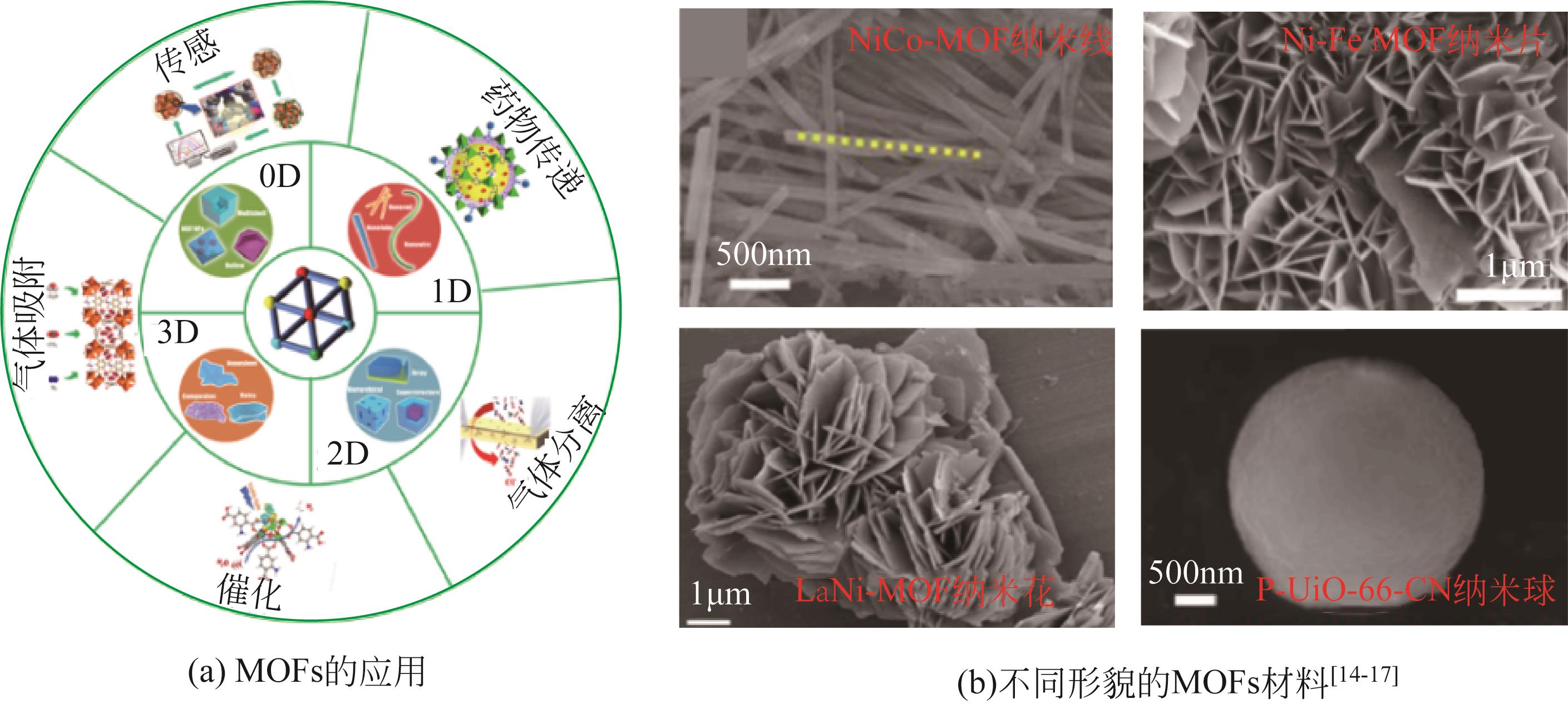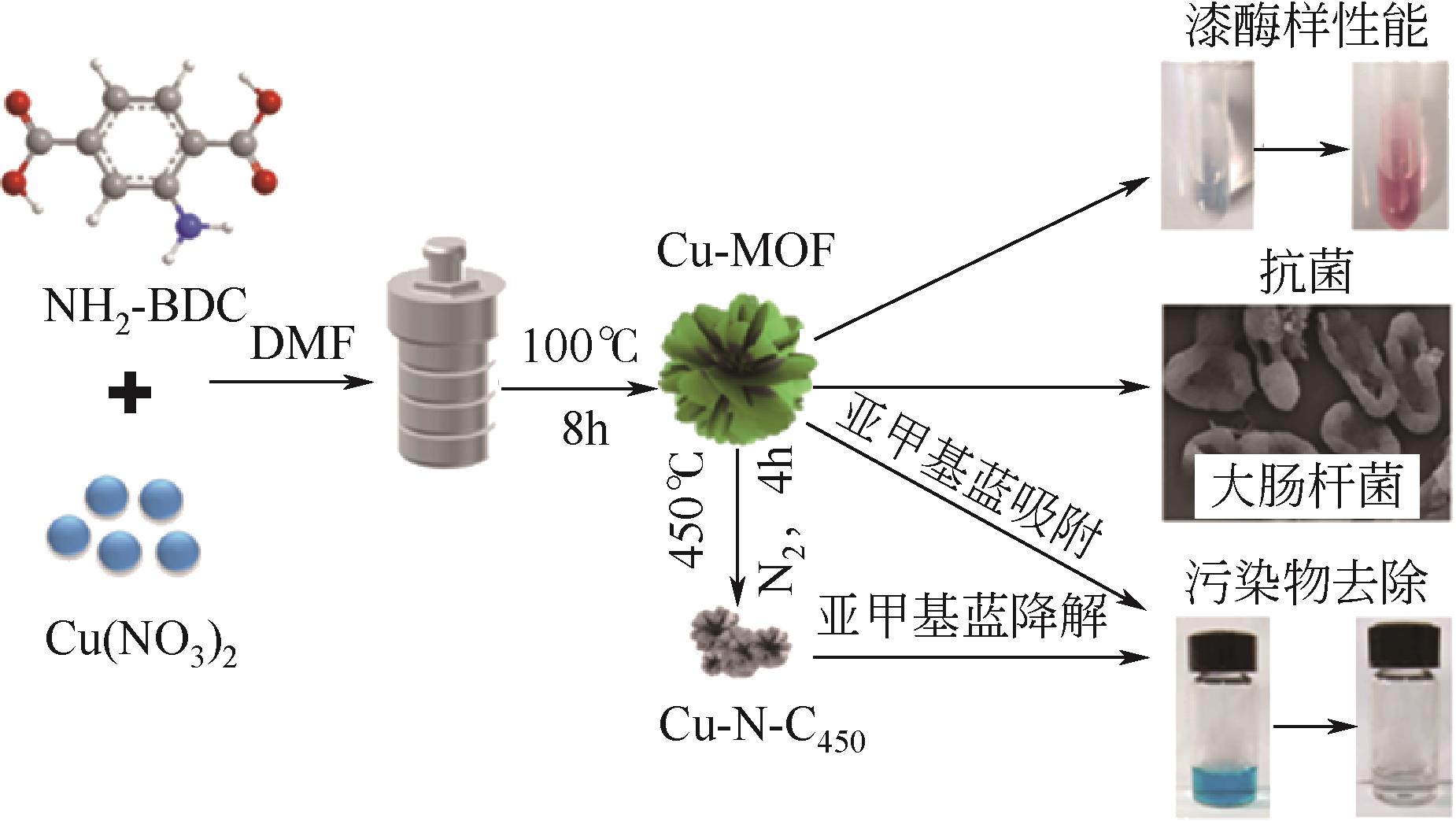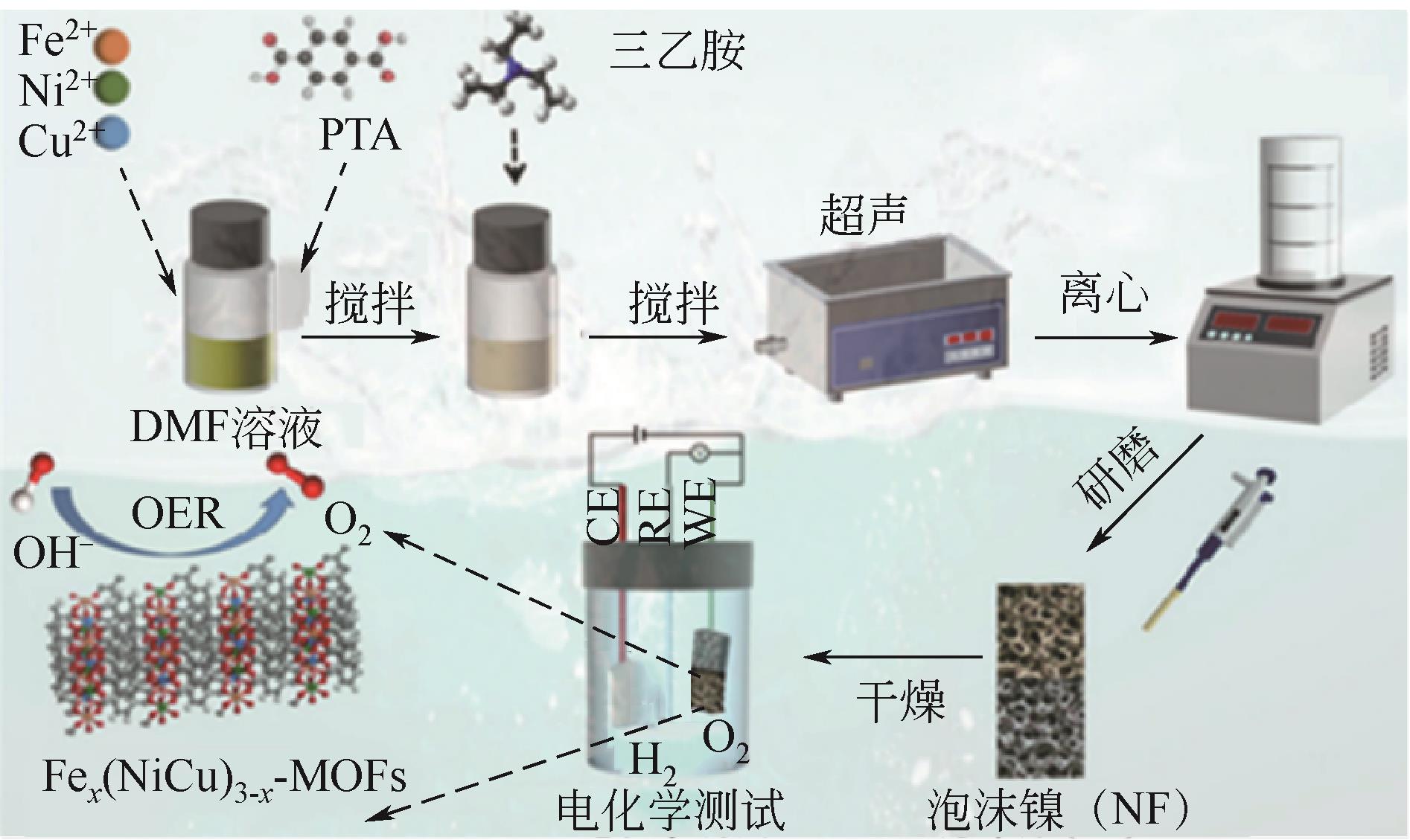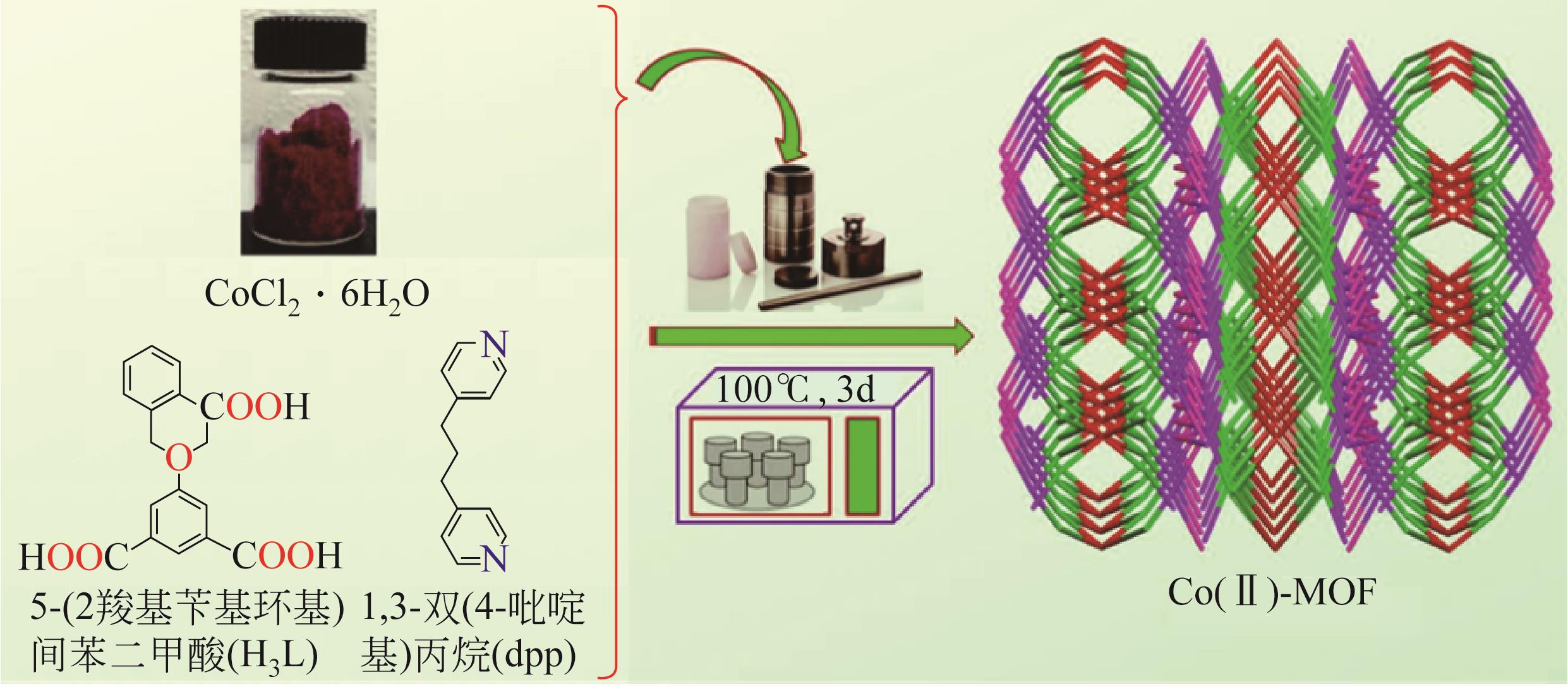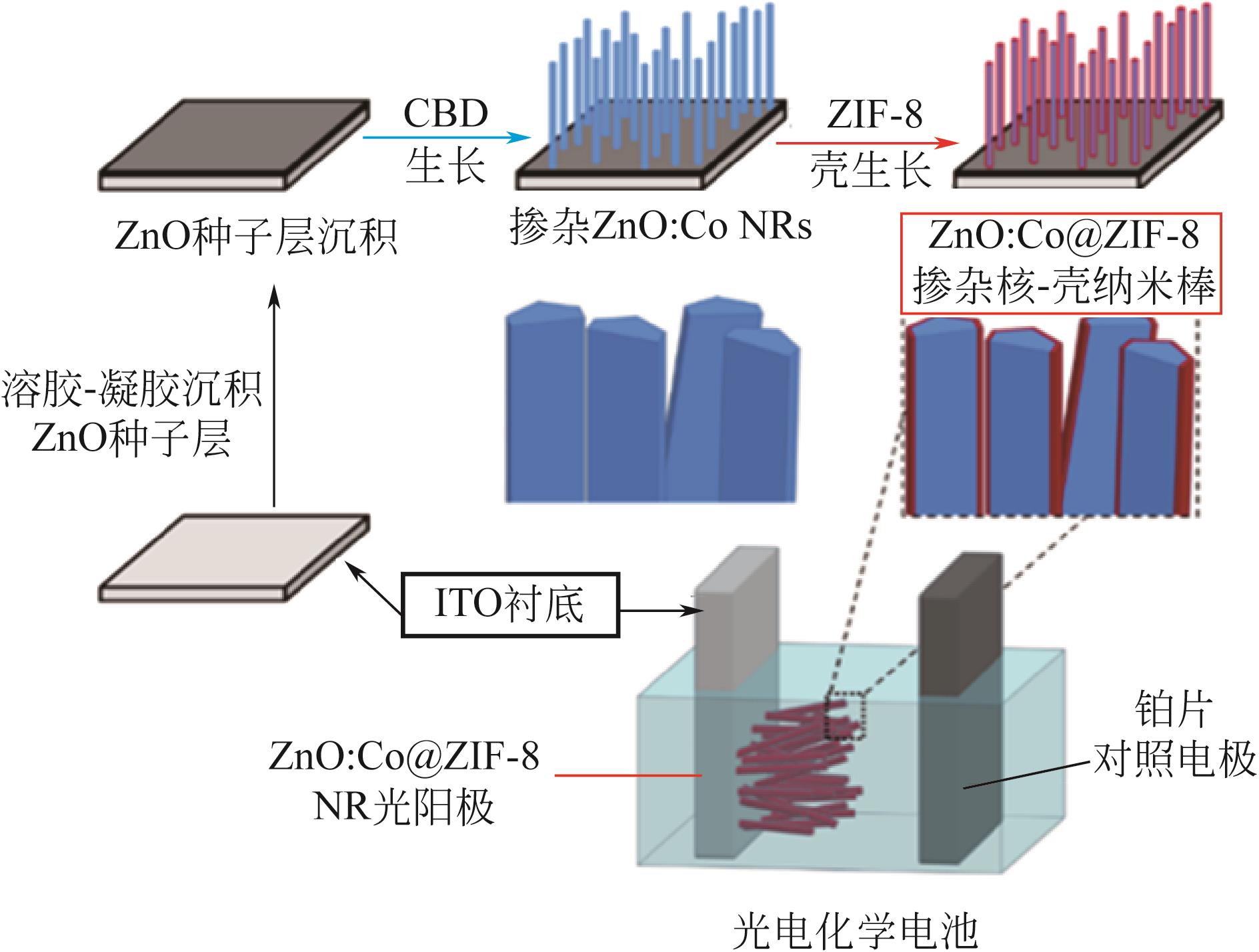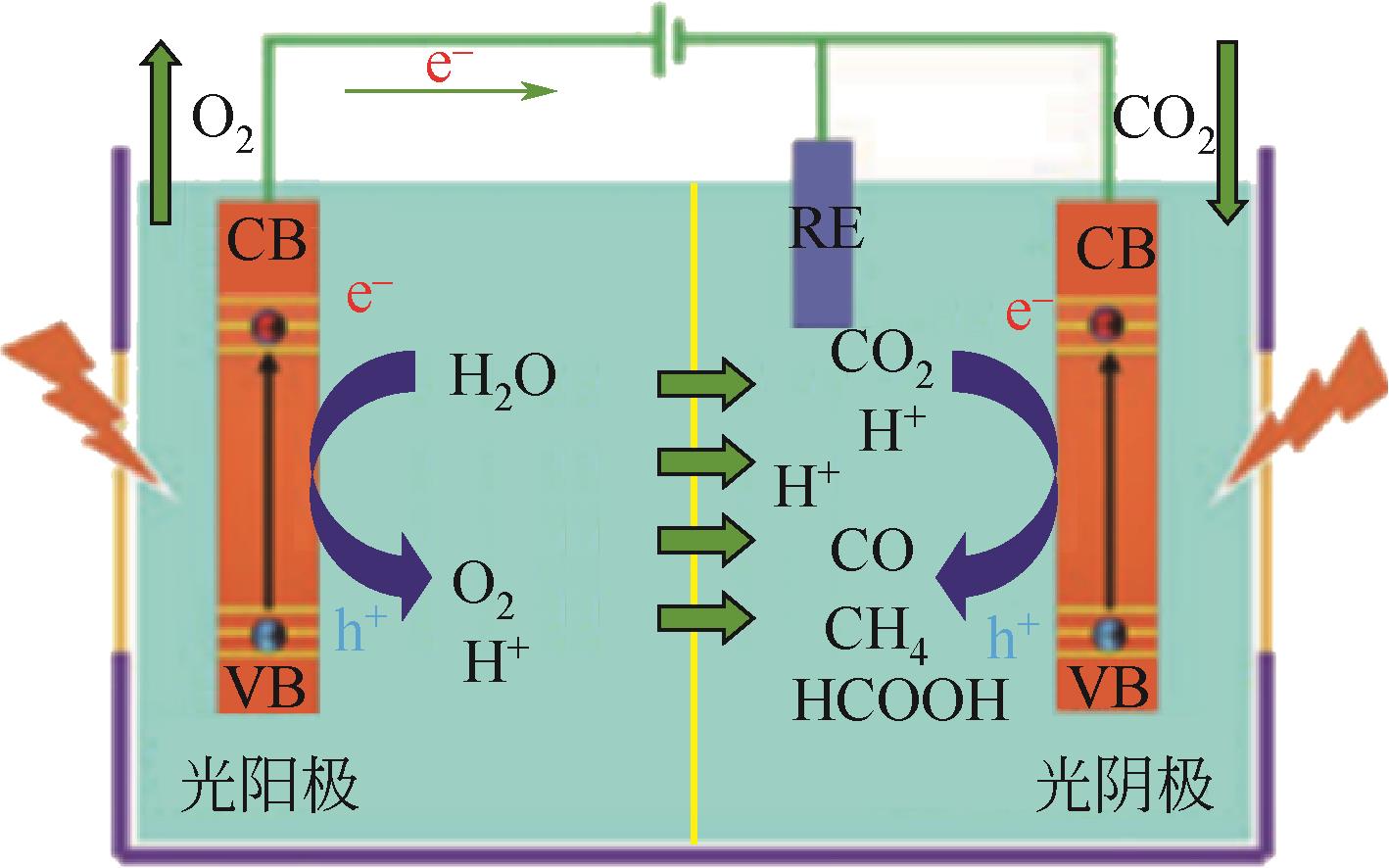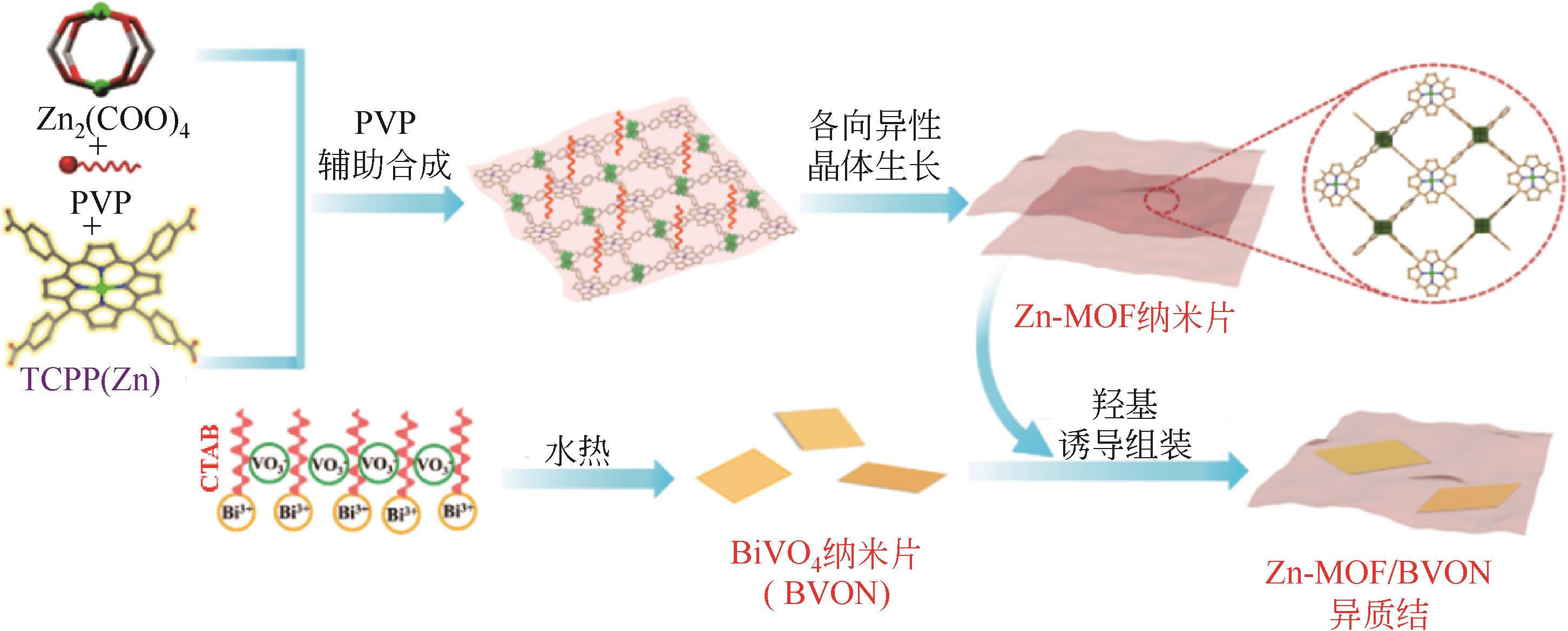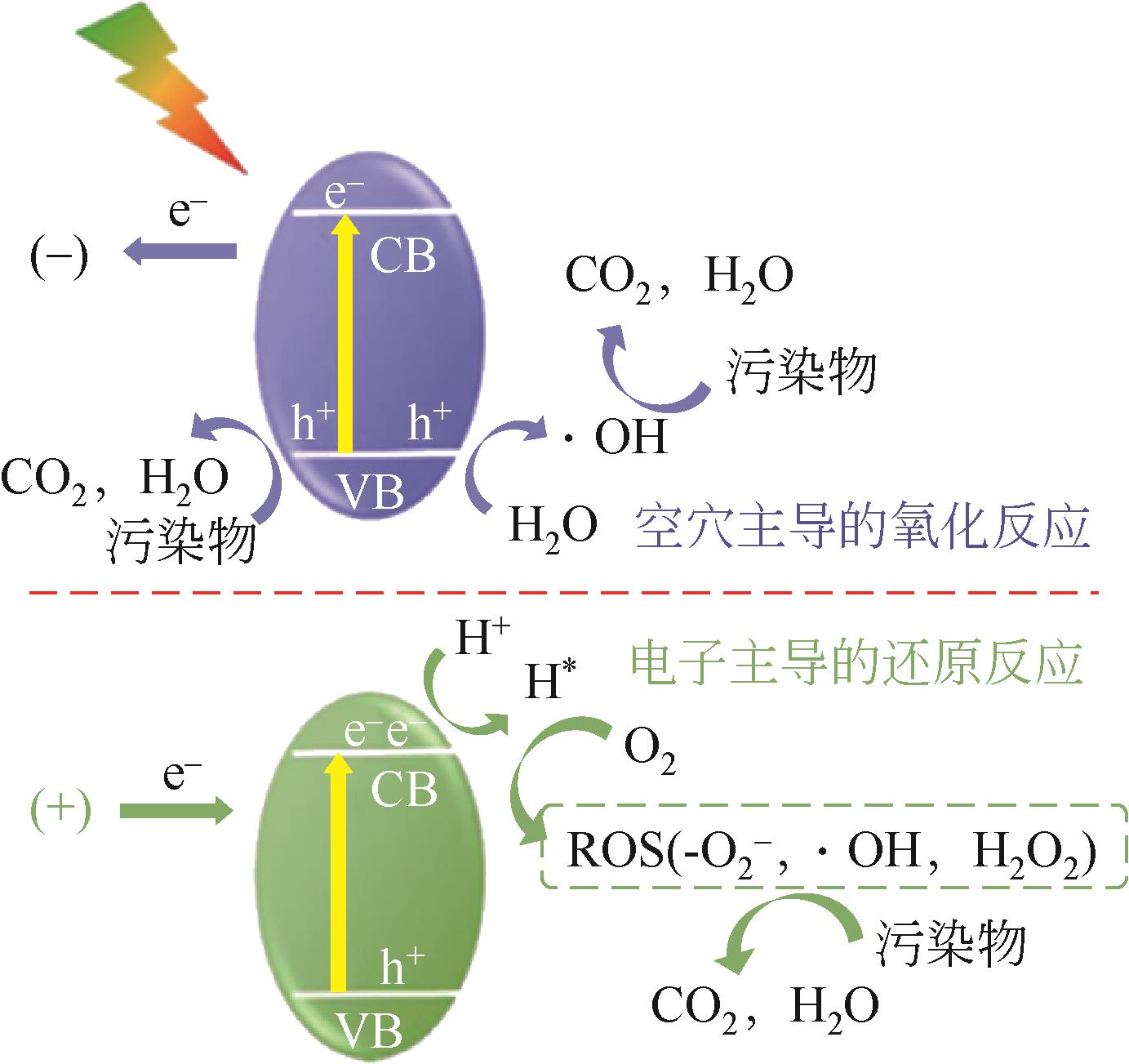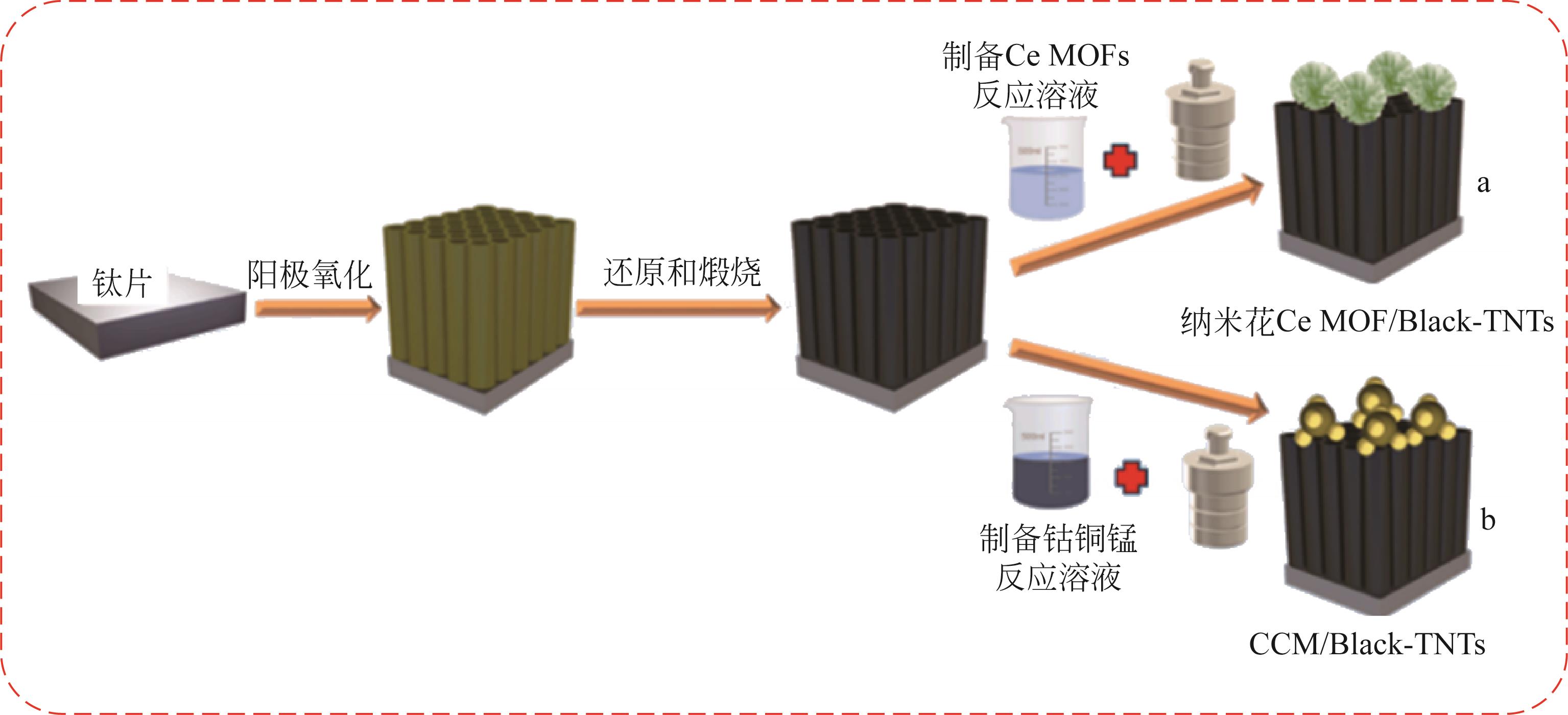Chemical Industry and Engineering Progress ›› 2023, Vol. 42 ›› Issue (9): 4692-4705.DOI: 10.16085/j.issn.1000-6613.2023-0598
• Industrial catalysis • Previous Articles Next Articles
Research progress on the application of MOFs in photoelectrocatalysis
GE Quanqian1,2( ), XU Mai2(
), XU Mai2( ), LIANG Xian2, WANG Fengwu2(
), LIANG Xian2, WANG Fengwu2( )
)
- 1.School of Materials Science and Engineering, Anhui University of Science and Technology, Huainan 232001, Anhui, China
2.School of Chemistry and Material Engineering, Huainan Normal University, Huainan 232038, Anhui, China
-
Received:2023-04-14Revised:2023-05-18Online:2023-09-28Published:2023-09-15 -
Contact:XU Mai, WANG Fengwu
MOFs材料在光电催化领域应用的研究进展
- 1.安徽理工大学材料科学与工程学院,安徽 淮南 232001
2.淮南师范学院化学与材料工程学院,安徽 淮南 232038
-
通讯作者:徐迈,王凤武 -
作者简介:葛全倩(1998—),女,硕士研究生,研究方向为光电催化纳米复合材料。E-mail:3288903561@qq.com。 -
基金资助:国家自然科学基金(22078121);安徽省高校自然科学基金重点项目(KJ2021A0963)
CLC Number:
Cite this article
GE Quanqian, XU Mai, LIANG Xian, WANG Fengwu. Research progress on the application of MOFs in photoelectrocatalysis[J]. Chemical Industry and Engineering Progress, 2023, 42(9): 4692-4705.
葛全倩, 徐迈, 梁铣, 王凤武. MOFs材料在光电催化领域应用的研究进展[J]. 化工进展, 2023, 42(9): 4692-4705.
share this article
Add to citation manager EndNote|Ris|BibTeX
URL: https://hgjz.cip.com.cn/EN/10.16085/j.issn.1000-6613.2023-0598
| 工艺 | 优点 | 缺点 | 实例 |
|---|---|---|---|
| 溶剂热/水热法 | 无须特定的设备、结晶度高和形貌好 | 耗时、溶剂用量大、不经济环保 | MIL-125[ |
| 电化学法 | 操作条件简单、合成速度快、能耗低、对设备无特殊要求 | 产率低、容易产生副产物 | MIL-101(Fe)[ |
| 机械力化学法 | 合成效率高、反应条件温和 | 晶体结构差、杂质多 | MOF-74[ |
| 超声法 | 经济环保、产率高、反应条件温和 | 反应不易控制、杂质多 | HKUST-1[ |
| 微波法 | 反应时间短、环保、易操作 | 实验需要精密仪器 | MIL-100 (Fe)[ |
| 工艺 | 优点 | 缺点 | 实例 |
|---|---|---|---|
| 溶剂热/水热法 | 无须特定的设备、结晶度高和形貌好 | 耗时、溶剂用量大、不经济环保 | MIL-125[ |
| 电化学法 | 操作条件简单、合成速度快、能耗低、对设备无特殊要求 | 产率低、容易产生副产物 | MIL-101(Fe)[ |
| 机械力化学法 | 合成效率高、反应条件温和 | 晶体结构差、杂质多 | MOF-74[ |
| 超声法 | 经济环保、产率高、反应条件温和 | 反应不易控制、杂质多 | HKUST-1[ |
| 微波法 | 反应时间短、环保、易操作 | 实验需要精密仪器 | MIL-100 (Fe)[ |
| 催化剂 | 金属中心 | 电解质 | 光电流密度(vs. RHE 1.230V)/mA·cm-2 | 参考文献 |
|---|---|---|---|---|
| TiO2/NH2⁃MIL⁃125 | Ti | 1mol/L NaOH | 1.63 | [ |
| BiVO4@CoNi⁃MOF | Co/Ni | 0.5mol/L Na2SO4 | 3.20 | [ |
| TiO2//UiO⁃67 | Zr | 1mol/L H2SO4 | 2.10 | [ |
| Co3O4@NH2⁃MOF⁃5/NF | Zn | 1mol/L KOH | 32.93 | [ |
| Mn(Ⅱ)-FeBTC/NIF | Fe | 0.1mol/L KOH | — | [ |
| α-Fe2O3@Ag@ZIF-67 | Co | 0.1mol/L NaOH | 1.04 | [ |
| 催化剂 | 金属中心 | 电解质 | 光电流密度(vs. RHE 1.230V)/mA·cm-2 | 参考文献 |
|---|---|---|---|---|
| TiO2/NH2⁃MIL⁃125 | Ti | 1mol/L NaOH | 1.63 | [ |
| BiVO4@CoNi⁃MOF | Co/Ni | 0.5mol/L Na2SO4 | 3.20 | [ |
| TiO2//UiO⁃67 | Zr | 1mol/L H2SO4 | 2.10 | [ |
| Co3O4@NH2⁃MOF⁃5/NF | Zn | 1mol/L KOH | 32.93 | [ |
| Mn(Ⅱ)-FeBTC/NIF | Fe | 0.1mol/L KOH | — | [ |
| α-Fe2O3@Ag@ZIF-67 | Co | 0.1mol/L NaOH | 1.04 | [ |
| 催化技术 | 特点 | 不足 |
|---|---|---|
| 光催化 | 需要光照,利用太阳能,经济环保,产品收率高,催化剂可重复使用且高度稳定,反应条件温和,耗能少 | 电子转移机理复杂,产物选择性差,反应完成时催化剂难以从产物中分离催化剂,需要牺牲供体 |
| 电催化 | 涉及偏置电压,主要在室温下进行反应 | 催化剂寿命短,需要电能,成本高 |
| 光电催化 | 需要照明,涉及偏置电压,不需要牺牲试剂,成本效益高 | 催化剂的复合设计 |
| 催化技术 | 特点 | 不足 |
|---|---|---|
| 光催化 | 需要光照,利用太阳能,经济环保,产品收率高,催化剂可重复使用且高度稳定,反应条件温和,耗能少 | 电子转移机理复杂,产物选择性差,反应完成时催化剂难以从产物中分离催化剂,需要牺牲供体 |
| 电催化 | 涉及偏置电压,主要在室温下进行反应 | 催化剂寿命短,需要电能,成本高 |
| 光电催化 | 需要照明,涉及偏置电压,不需要牺牲试剂,成本效益高 | 催化剂的复合设计 |
| 催化 | 还原效率 | 光电流密度 /mA·cm-2 | 反应条件 | 参考文献 |
|---|---|---|---|---|
| C-ZnZIF700 | 90.17μmol·g-1·h-1 CH3OH | — | 0.1mol/L KHCO3, 2V(vs. Ag/AgCl) | [ |
| Cu/Cu2O-Cu (BDC-NH2) | 674μmol·L-1 CH3OH | 2.5 | 300W氙气孤光灯,0.1mol/L Na2SO4,+0.1V | [ |
| Cu3(BTC)2/Cu2O | 还原为CO的效率为95% | — | 300W氙灯,0.1mol/L六氟磷酸四丁基铵 | [ |
| MOF转化为In2O3-x@C | 还原为HCOOH的效率为97% | — | 1mol/L KOH,-1.0V(vs. RHE) | [ |
| Bi2S3/ZIF-8 | 还原为甲酸盐的效率为74.2% | 16.1 | 300W 氙灯,0.7V(vs. RHE) | [ |
| NH2-UiO-66 @MIL-101 | 267.90μmol·h-1·g-1 CO和18.63μmol·h-1·g-1 CH4 | 1.23 | 300W氙灯 | [ |
| 催化 | 还原效率 | 光电流密度 /mA·cm-2 | 反应条件 | 参考文献 |
|---|---|---|---|---|
| C-ZnZIF700 | 90.17μmol·g-1·h-1 CH3OH | — | 0.1mol/L KHCO3, 2V(vs. Ag/AgCl) | [ |
| Cu/Cu2O-Cu (BDC-NH2) | 674μmol·L-1 CH3OH | 2.5 | 300W氙气孤光灯,0.1mol/L Na2SO4,+0.1V | [ |
| Cu3(BTC)2/Cu2O | 还原为CO的效率为95% | — | 300W氙灯,0.1mol/L六氟磷酸四丁基铵 | [ |
| MOF转化为In2O3-x@C | 还原为HCOOH的效率为97% | — | 1mol/L KOH,-1.0V(vs. RHE) | [ |
| Bi2S3/ZIF-8 | 还原为甲酸盐的效率为74.2% | 16.1 | 300W 氙灯,0.7V(vs. RHE) | [ |
| NH2-UiO-66 @MIL-101 | 267.90μmol·h-1·g-1 CO和18.63μmol·h-1·g-1 CH4 | 1.23 | 300W氙灯 | [ |
| 催化剂 | 有机污染物 | 光源 | 降解效率 | 参考文献 |
|---|---|---|---|---|
| Ti-Zr MOF | 乙酰氨基酚 | 模拟太阳光 | 在90min内达到90% | [ |
| Co-MIL-53-NH-BT | 双酚A | 可见光(500W 氙灯) | 在120min内达到99.9% | [ |
| Bi5O7I/UiO-66-NH2 | 环丙沙星 | 白光 | 在120min内达到96.1% | [ |
| MOF-5/LTH | 亚甲基蓝 | 紫外光(150W 氙灯) | 在125min内达到98.1% | [ |
| UiO-66@TiO2 | 二甲基硫醚 | UV灯 | 在80min内达到99% | [ |
| NH2-La MOFs/Black TNTs | 2,4-二氯苯酚 | 可见光(300W 氙灯) | 在180min内达到99% | [ |
| 催化剂 | 有机污染物 | 光源 | 降解效率 | 参考文献 |
|---|---|---|---|---|
| Ti-Zr MOF | 乙酰氨基酚 | 模拟太阳光 | 在90min内达到90% | [ |
| Co-MIL-53-NH-BT | 双酚A | 可见光(500W 氙灯) | 在120min内达到99.9% | [ |
| Bi5O7I/UiO-66-NH2 | 环丙沙星 | 白光 | 在120min内达到96.1% | [ |
| MOF-5/LTH | 亚甲基蓝 | 紫外光(150W 氙灯) | 在125min内达到98.1% | [ |
| UiO-66@TiO2 | 二甲基硫醚 | UV灯 | 在80min内达到99% | [ |
| NH2-La MOFs/Black TNTs | 2,4-二氯苯酚 | 可见光(300W 氙灯) | 在180min内达到99% | [ |
| 66 | KIM Manuela Leticia, BARRERA Deicy, KIMURA Mutsumi, et al. Effect of the ethanol/BTC ratio on the methane uptake of mechanochemically synthesized MOF-199[J]. Chemistry: an Asian Journal, 2021, 16(9): 1086-1091. |
| 67 | Nasiri AZAD F, GHAEDI M, DASHTIAN K, et al. Ultrasonically assisted hydrothermal synthesis of activated carbon-HKUST-1-MOF hybrid for efficient simultaneous ultrasound-assisted removal of ternary organic dyes and antibacterial investigation: Taguchi optimization[J]. Ultrasonics Sonochemistry, 2016, 31: 383-393. |
| 68 | CHO Hye-Young, KIM Jun, KIM Se-Na, et al. High yield 1-L scale synthesis of ZIF-8 via a sonochemical route[J]. Microporous and Mesoporous Materials, 2013, 169: 180-184. |
| 69 | AGUIAR Laís W, OTTO Guilherme P, KUPFER Vicente L, et al. Simple, fast, and low-cost synthesis of MIL-100 and MIL-88B in a modified domestic microwave oven[J]. Materials Letters, 2020, 276: 128127. |
| 70 | David TILLEY S. Recent advances and emerging trends in photo-electrochemical solar energy conversion[J]. Advanced Energy Materials, 2019, 9(2): 1802877. |
| 71 | 史潇凡, 朱剑, 白田宇, 等. 金属-有机框架材料在光电催化水分解领域的研究进展[J]. 高等学校化学学报, 2022, 43(1): 126-138. |
| SHI Xiaofan, ZHU Jian, BAI Tianyu, et al. Research status and progress of MOFs with application in photoelectrochemical water-splitting[J]. Chemical Journal of Chinese Universities, 2022, 43(1): 126-138. | |
| 72 | YUAN Yongjun, CHEN Daqin, YU Zhentao, et al. Cadmium sulfide-based nanomaterials for photocatalytic hydrogen production[J]. Journal of Materials Chemistry A, 2018, 6(25): 11606-11630. |
| 73 | FUJISHIMA Akira, HONDA Kenichi. Electrochemical photolysis of water at a semiconductor electrode[J]. Nature, 1972, 238(5358): 37-38. |
| 74 | BIBI Rehana, HUANG Hailu, KALULU Mulenga, et al. Synthesis of amino-functionalized Ti-MOF derived yolk-shell and hollow heterostructures for enhanced photocatalytic hydrogen production under visible light[J]. ACS Sustainable Chemistry & Engineering, 2019, 7(5): 4868-4877. |
| 75 | ZUO Quan, LIU Tingting, CHEN Chuanshuang, et al. Ultrathin metal-organic framework nanosheets with ultrahigh loading of single Pt atoms for efficient visible-light-driven photocatalytic H2 evolution[J]. Angewandte Chemie International Edition, 2019, 58(30): 10198-10203. |
| 76 | PAILLE Grégoire, Maria GOMEZ-MINGOT, Catherine ROCH-MARCHAL, et al. Thin films of fully noble metal-free POM@MOF for photocatalytic water oxidation[J]. ACS Applied Materials & Interfaces, 2019, 11(51): 47837-47845. |
| 77 | LI Fei, WANG Dengke, XING Qiuju, et al. Design and syntheses of MOF/COF hybrid materials via postsynthetic covalent modification: An efficient strategy to boost the visible-light-driven photocatalytic performance[J]. Applied Catalysis B: Environmental, 2019, 243: 621-628. |
| 78 | NATARAJAN Kaushik, GUPTA Anoop K, ANSARI Shagufi Naz, et al. Mixed-ligand-architected 2D Co( Ⅱ )-MOF expressing a novel topology for an efficient photoanode for water oxidation using visible light[J]. ACS Applied Materials & Interfaces, 2019, 11(14): 13295-13303. |
| 79 | GONG Yunnan, OUYANG Ting, HE Chunting, et al. Photoinduced water oxidation by an organic ligand incorporated into the framework of a stable metal-organic framework[J]. Chemical Science, 2016, 7(2): 1070-1075. |
| 80 | Alejandro GALÁN-GONZÁLEZ, SIVAN Aswathi K, Javier HERNÁNDEZ-FERRER, et al. Cobalt-doped ZnO nanorods coated with nanoscale metal-organic framework shells for water-splitting photoanodes[J]. ACS Applied Nano Materials, 2020, 3(8): 7781-7788. |
| 81 | VADDIPALLI Srinivasa Rao, SANIVARAPU Suresh Reddy, VENGATESAN Singaram, et al. Heterostructured Au NPs/CdS/LaBTC MOFs photoanode for efficient photoelectrochemical water splitting: Stability enhancement via CdSe QDs to 2D-CdS nanosheets transformation[J]. ACS Applied Materials & Interfaces, 2016, 8(35): 23049-23059. |
| 82 | ZHANG Liping, CUI Ping, YANG Hongbin, et al. Metal-organic frameworks as promising photosensitizers for photoelectrochemical water splitting[J]. Advanced Science, 2016, 3(1): 1500243. |
| 83 | ZHOU Shiqian, CHEN Kaiyi, HUANG Jingwei, et al. Preparation of heterometallic CoNi-MOFs-modified BiVO4: A steady photoanode for improved performance in photoelectrochemical water splitting[J]. Applied Catalysis B: Environmental, 2020, 266: 118513. |
| 84 | WANG Xuewei, SUN Wenming, TIAN Yang, et al. Conjugated π electrons of MOFs drive charge separation at heterostructures interface for enhanced photoelectrochemical water oxidation[J]. Small, 2021, 17(14): 2100367. |
| 85 | FIAZ Muhammad, HUSSAIN Dilshad, ATHAR Muhammad. Synthesis of transition metal oxide incorporated MOF-5 and NH2-MOF-5 as efficient photoanode for oxygen evolution reaction[J]. Ionics, 2021, 27(2): 759-770. |
| 86 | DONG Yiwen, LIU Haijun, WANG Xiao, et al. Manganese doping regulated the built-in electric field of FeBTC for enhanced photoelectrocatalytic hydrolysis[J]. Applied Catalysis B: Environmental, 2023, 328: 122464. |
| 87 | JI Chengyu, XU Jiamin, JIANG Qianfan, et al. Significantly boosted photoelectrochemical water splitting performance by plasmonic enhanced[email protected]composite photoelectrodes[J]. Materials Today Advances, 2023, 18: 100361. |
| 88 | LI Chufan, GUO Ruitang, WU Tong, et al. Progress and perspectives on 1D nanostructured catalysts applied in photo(electro)catalytic reduction of CO2 [J]. Nanoscale, 2022, 14(43): 16033-16064. |
| 89 | IRIKURA Kallyni, PERINI João Angelo Lima, FLOR Jader Barbosa Silva, et al. Direct synthesis of Ru3(BTC)2 metal-organic framework on a Ti/TiO2NT platform for improved performance in the photoelectroreduction of CO2 [J]. Journal of CO2 Utilization, 2021, 43: 101364. |
| 1 | 郭瑞梅, 白金泉, 张恒, 等. 金属-有机骨架材料在催化氧化反应中的应用[J]. 化学进展, 2016, 28(S2): 232-243. |
| GUO Ruimei, BAI Jinquan, ZHANG Heng, et al. Metal-organic frameworks for catalytic oxidation[J]. Progress in Chemistry, 2016, 28(S2): 232-243. | |
| 2 | CARDOSO J C, STULP S, DE BRITO J F, et al. MOFs based on ZIF-8 deposited on TiO2 nanotubes increase the surface adsorption of CO2 and its photoelectrocatalytic reduction to alcohols in aqueous media[J]. Applied Catalysis B: Environmental, 2018, 225: 563-573. |
| 3 | HOSKINS Bernard F, ROBSON Richard. Infinite polymeric frameworks consisting of three dimensionally linked rod-like segments[J]. Journal of the American Chemical Society, 1989, 111(15): 5962-5964. |
| 4 | YAGHI O M, LI Guangming, LI Hailian. Selective binding and removal of guests in a microporous metal-organic framework[J]. Nature, 1995, 378(6558): 703-706. |
| 5 | DOU Shuo, LI Xiaogang, WANG Xin. Rational design of metal-organic frameworks towards efficient electrocatalysis[J]. ACS Materials Letters, 2020, 2(9): 1251-1267. |
| 6 | AMARAJOTHI Dhakshinamoorthy, LI Zhaohui, HERMENEGILDO Garcia. Catalysis and photocatalysis by metal organic frameworks[J]. Chemical Society Reviews, 2018, 47(22): 8134-8172. |
| 7 | GAO Junkuo, HUANG Qing, WU Yuhang, et al. Metal-organic frameworks for photo/electrocatalysis[J]. Advanced Energy and Sustainability Research, 2021, 2(8): 2100033. |
| 8 | LI Jiantang, BHATT Prashant M, LI Jiyang, et al. Recent progress on microfine design of metal-organic frameworks: Structure regulation and gas sorption and separation[J]. Advanced Materials, 2020, 32(44): 2002563. |
| 9 | FENG Yuyan, WANG Yixian, YING Yibin. Structural design of metal-organic frameworks with tunable colorimetric responses for visual sensing applications[J]. Coordination Chemistry Reviews, 2021, 446: 214102. |
| 10 | LAWSON Harrison D, Patrick WALTON S, CHAN Christina. Metal-organic frameworks for drug delivery: A design perspective[J]. ACS Applied Materials & Interfaces, 2021, 13(6): 7004-7020. |
| 11 | LI Xiaomin, WANG Yameng, MU Yongbiao, et al. Superprotonic conductivity of a functionalized metal-organic framework at ambient conditions[J]. ACS Applied Materials & Interfaces, 2022, 14(7): 9264-9271. |
| 90 | TANG Bo, XIAO Fangxing. An overview of solar-driven photoelectrochemical CO2 conversion to chemical fuels[J]. ACS Catalysis, 2022, 12(15): 9023-9057. |
| 91 | ZHAO Jian, XUE Song, JAMES Barber, et al. An overview of Cu-based heterogeneous electrocatalysts for CO2 reduction[J]. Journal of Materials Chemistry A, 2020, 8(9): 4700-4734. |
| 92 | LI Chufan, GUO Ruitang, ZHANG Zhenrui, et al. Converting CO2 into value-added products by Cu2O-based catalysts: From photocatalysis, electrocatalysis to photoelectrocatalysis[J]. Small, 2023, 19(19): 2207875. |
| 93 | MU Qiaoqiao, ZHU Wei, LI Xian, et al. Electrostatic charge transfer for boosting the photocatalytic CO2 reduction on metal centers of 2D MOF/rGO heterostructure[J]. Applied Catalysis B: Environmental, 2020, 262: 118144. |
| 94 | CARDOSO J C, STULP S, DE SOUZA M K R, et al. The effective role of ascorbic acid in the photoelectrocatalytic reduction of CO2 preconcentrated on TiO2 nanotubes modified by ZIF-8[J]. Journal of Electroanalytical Chemistry, 2020, 856: 113384. |
| 95 | SHEN Kui, CHEN Xiaodong, CHEN Junying, et al. ChemInform abstract: Development of MOF-derived carbon-based nanomaterials for efficient catalysis[J]. ChemInform, 2016, 47(43): 5887-5903. |
| 96 | REN Qian, WANG Hui, LU Xuefeng, et al. Recent progress on MOF-derived heteroatom-doped carbon-based electrocatalysts for oxygen reduction reaction[J]. Advanced Science, 2018, 5(3): 1700515. |
| 97 | DENG Xi, LI Rui, WU Sikai, et al. Metal-organic framework coating enhances the performance of Cu2O in photoelectrochemical CO2 reduction[J]. Journal of the American Chemical Society, 2019, 141(27): 10924-10929. |
| 98 | SILVA Beatriz Costa E, IRIKURA Kallyni, FLOR Jader Barbosa Silva, et al. Electrochemical preparation of Cu/Cu2O-Cu(BDC) metal-organic framework electrodes for photoelectrocatalytic reduction of CO2 [J]. Journal of CO2 Utilization, 2020, 42: 101299. |
| 99 | MAINA James W, Cristina POZO-GONZALO, SCHÜTZ Jürg A, et al. Tuning CO2 conversion product selectivity of metal organic frameworks derived hybrid carbon photoelectrocatalytic reactors[J]. Carbon, 2019, 148: 80-90. |
| 100 | SILVA Beatriz Costa E, IRIKURA Kallyni, FREM Regina Célia Galvão, et al. Effect of Cu(BDC-NH2) MOF deposited on Cu/Cu2O electrode and its better performance in photoelectrocatalytic reduction of CO2 [J]. Journal of Electroanalytical Chemistry, 2021, 880: 114856. |
| 101 | ZHAO Zhenlong, BIAN Ji, ZHAO Lina, et al. Construction of 2D Zn-MOF/BiVO4 S-scheme heterojunction for efficient photocatalytic CO2 conversion under visible light irradiation[J]. Chinese Journal of Catalysis, 2022, 43(5): 1331-1340. |
| 12 | WANG Sibo, HOU Yidong, LIN Sen, et al. Water oxidation electrocatalysis by a zeolitic imidazolate framework[J]. Nanoscale, 2014, 6(17): 9930-9934. |
| 13 | KUNG Chung-Wei, HAN Pochun, CHUANG Cheng-Hsun, et al. Electronically conductive metal-organic framework-based materials[J]. APL Materials, 2019, 7(11): 110902. |
| 14 | HAN Mengyi, ZHAO Zhiyong, ZHANG Xiaowei, et al. Phosphorus-doped directly interconnected networks of amorphous Metal-organic framework nanowires for efficient methanol oxidation[J]. Journal of Colloid and Interface Science, 2023, 641: 675-684. |
| 15 | LIU Yizhe, LI Xintong, SUN Qidi, et al. Freestanding 2D NiFe metal-organic framework nanosheets: Facilitating proton transfer via organic ligands for efficient oxygen evolution reaction[J]. Small, 2022, 18(26): 2201076. |
| 16 | LI Lifang, PENG Hui, KANG Yumao, et al. Rare-earth metal-organic framework-derived La2O3/Ni x P y nanoparticles embedded in nitrogen-doped porous carbon as efficient electrocatalysts for the oxygen evolution reaction[J]. ACS Applied Nano Materials, 2023, 6(6): 4349-4359. |
| 17 | MA Lin, HUANG Chen, YAO Yunyou, et al. Self-assembled MOF microspheres with hierarchical porous structure for efficient uranium adsorption[J]. Separation and Purification Technology, 2023, 314: 123526. |
| 18 | QIU Tianjie, LIANG Zibin, GUO Wenhan, et al. Metal-organic framework-based materials for energy conversion and storage[J]. ACS Energy Letters, 2020, 5(2): 520-532. |
| 19 | LI Hailian, EDDAOUDI Mohamed, GROY Thomas L, et al. Establishing microporosity in open metal-organic frameworks: Gas sorption isotherms for Zn(BDC) (BDC=1,4-benzenedicarboxylate)[J]. Journal of the American Chemical Society, 1998, 120(33): 8571-8572. |
| 20 | LI Hailian, EDDAOUDI Mohamed, O'KEEFFE M, et al. Design and synthesis of an exceptionally stable and highly porous metal-organic framework[J]. Nature, 1999, 402(6759): 276-279. |
| 21 | CHUI S S, LO S M, CHARMANT J P, et al. A chemically functionalizable nanoporous material[J]. Science, 1999, 283(5405): 1148-1150. |
| 22 | BORDIGA S, LAMBERTI C, RICCHIARDI G, et al. Electronic and vibrational properties of a MOF-5 metal-organic framework: ZnO quantum dot behaviour[J]. Chemical Communications, 2004(20): 2300-2301. |
| 23 | FUJITA Makoto, KWON Yoon Jung, WASHIZU Satoru, et al. Preparation, clathration ability, and catalysis of a two-dimensional square network material composed of cadmium(Ⅱ) and 4,4'-bipyridine[J]. Journal of the American Chemical Society, 1994, 116(3): 1151-1152. |
| 24 | ALVARO Mercedes, CARBONELL Esther, FERRER Belén, et al. Semiconductor behavior of a metal-organic framework (MOF)[J]. Chemistry: a European Journal, 2007, 13(18): 5106-5112. |
| 102 | GULATI Shikha, VIJAYAN Sneha, KUMAR Sanjay, et al. Recent advances in the application of metal-organic frameworks (MOFs)-based nanocatalysts for direct conversion of carbon dioxide(CO2) to value-added chemicals[J]. Coordination Chemistry Reviews, 2023, 474: 214853. |
| 103 | QIU Chen, QIAN Kun, YU Jun, et al. MOF-transformed In2O3- x @C nanocorn electrocatalyst for efficient CO2 reduction to HCOOH[J]. Nano-Micro Letters, 2022, 14(1): 167. |
| 104 | KONG Nan, DU Huiling, LI Zhuo, et al. Nano heterojunction of double MOFs for improved CO2 photocatalytic reduction performance[J]. Colloids and Surfaces A: Physicochemical and Engineering Aspects, 2023, 663: 131005. |
| 105 | WU Hao, TAN Huiling, Cui Ying TOE, et al. Photocatalytic and photoelectrochemical systems: Similarities and differences[J]. Advanced Materials, 2020, 32(18): 1904717. |
| 106 | BRILLAS Enric. Recent development of electrochemical advanced oxidation of herbicides. A review on its application to wastewater treatment and soil remediation[J]. Journal of Cleaner Production, 2021, 290: 125841. |
| 107 | ZHANG Lu, SHI Qin, GUO Yuye, et al. Interface optimization by impedance spectroscopy and photoelectrocatalytic degradation of clofibric acid[J]. Electrochimica Acta, 2019, 300: 242-252. |
| 108 | YAO Tingting, AN Xiurui, HAN Hongxian, et al. Photoelectrocatalytic materials for solar water splitting[J]. Advanced Energy Materials, 2018, 8(21): 1800210. |
| 109 | ZHANG Xinyu, YU Wenchao, GUO Yajie, et al. Recent advances in photoelectrocatalytic advanced oxidation processes: From mechanism understanding to catalyst design and actual applications[J]. Chemical Engineering Journal, 2023, 455: 140801. |
| 110 | MO Fan, ZHOU Qixing, WANG Qi, et al. The applications of MOFs related materials in photo/electrochemical decontamination: An updated review[J]. Chemical Engineering Journal, 2022, 450: 138326. |
| 111 | MAHMOODI Niyaz Mohammad, ABDI Jafar, OVEISI Mina, et al. Metal-organic framework (MIL-100 (Fe)): Synthesis, detailed photocatalytic dye degradation ability in colored textile wastewater and recycling[J]. Materials Research Bulletin, 2018, 100: 357-366. |
| 112 | MAHMOODI Niyaz Mohammad, ABDI Jafar, TAGHIZADEH Mohsen, et al. Activated carbon/metal-organic framework nanocomposite: Preparation and photocatalytic dye degradation mathematical modeling from wastewater by least squares support vector machine[J]. Journal of Environmental Management, 2019, 233: 660-672. |
| 113 | EL-FAWAL Esraa M, YOUNIS Sherif A, ZAKI T. Designing AgFeO2-graphene/Cu2(BTC)3 MOF heterojunction photocatalysts for enhanced treatment of pharmaceutical wastewater under sunlight[J]. Journal of Photochemistry and Photobiology A: Chemistry, 2020, 401: 112746. |
| 25 | YU Zhentao, LIAO Zuolei, JIANG Yusheng, et al. Construction of a microporous inorganic-organic hybrid compound with uranyl units[J]. Chemical Communications, 2004(16): 1814-1815. |
| 26 | MAHATA Partha, MADRAS Giridhar, NATARAJAN Srinivasan. Novel photocatalysts for the decomposition of organic dyes based on metal-organic framework compounds[J]. The Journal of Physical Chemistry B, 2006, 110(28): 13759-13768. |
| 27 | LIU Bo, HIROSHI Shioyama, TOMOKI Akita, et al. Metal-organic framework as a template for porous carbon synthesis[J]. Journal of the American Chemical Society, 2008, 130(16): 5390-5391. |
| 28 | KATAOKA Yusuke, SATO Konomi, MIYAZAKI Yuhei, et al. Photocatalytic hydrogen production from water using porous material[Ru2(p-BDC)2] n [J]. Energy & Environmental Science, 2009, 2(4): 397-400. |
| 29 | NOHRA Brigitte, MOLL Hani EL, RODRIGUEZ ALBELO L Marleny, et al. Polyoxometalate-based metal organic frameworks (POMOFs): Structural trends, energetics, and high electrocatalytic efficiency for hydrogen evolution reaction[J]. Journal of the American Chemical Society, 2011, 133(34): 13363-13374. |
| 30 | MA Tianyi, DAI Sheng, MIETEK Jaroniec, et al. Metal-organic framework derived hybrid Co3O4-carbon porous nanowire arrays as reversible oxygen evolution electrodes[J]. Journal of the American Chemical Society, 2014, 136(39): 13925-13931. |
| 31 | ZHANG Yan, HUANG Jingwei, DING Yong. Porous Co3O4/CuO hollow polyhedral nanocages derived from metal-organic frameworks with heterojunctions as efficient photocatalytic water oxidation catalysts[J]. Applied Catalysis B: Environmental, 2016, 198: 447-456. |
| 32 | WANG Cheng, XIE Zhigang, DEKRAFFT Kathryn E, et al. Doping metal-organic frameworks for water oxidation, carbon dioxide reduction, and organic photocatalysis[J]. Journal of the American Chemical Society, 2011, 133(34): 13445-13454. |
| 33 | LI Dandan, XU Haiqun, JIAO Long, et al. Metal-organic frameworks for catalysis: State of the art, challenges, and opportunities[J]. EnergyChem, 2019, 1(1): 100005. |
| 34 | MARK Kalaj, BENTZ Kyle C, SERGIO Ayala, et al. MOF-polymer hybrid materials: From simple composites to tailored architectures[J]. Chemical Reviews, 2020, 120(16): 8267-8302. |
| 35 | ZHANG Xi, WANG Jing, DONG Xingxing, et al. Functionalized metal-organic frameworks for photocatalytic degradation of organic pollutants in environment[J]. Chemosphere, 2020, 242: 125144. |
| 36 | JIANG Danni, XU Piao, WANG Han, et al. Strategies to improve metal organic frameworks photocatalyst’s performance for degradation of organic pollutants[J]. Coordination Chemistry Reviews, 2018, 376: 449-466. |
| 37 | RICE Allison M, MARTIN Corey R, GALITSKIY Vladimir A, et al. Photophysics modulation in photoswitchable metal-organic frameworks[J]. Chemical Reviews, 2020, 120(16): 8790-8813. |
| 38 | DI NUNZIO Maria Rosaria, Elena CABALLERO-MANCEBO, COHEN Boiko, et al. Photodynamical behaviour of MOFs and related composites: Relevance to emerging photon-based science and applications[J]. Journal of Photochemistry and Photobiology C: Photochemistry Reviews, 2020, 44: 100355. |
| 39 | ZHAO Xiaoxue, LI Jinze, LI Xin, et al. Design of metal-organic frameworks(MOFs)-based photocatalyst for solar fuel production and photo-degradation of pollutants[J]. Chinese Journal of Catalysis, 2021, 42(6): 872-903. |
| 40 | SWETHA S, JANANI B, Sudheer KHAN S. A critical review on the development of metal-organic frameworks for boosting photocatalysis in the fields of energy and environment[J]. Journal of Cleaner Production, 2022, 333: 130164. |
| 41 | HU Chen, XIAO Juanding, MAO Xiaodong, et al. Toughening mechanisms of epoxy resin using aminated metal-organic framework as additive[J]. Materials Letters, 2019, 240: 113-116. |
| 42 | ANNAMALAI Jayshree, MURUGAN Preethika, GANAPATHY Dhanraj, et al. Synthesis of various dimensional metal organic frameworks (MOFs) and their hybrid composites for emerging applications—A review[J]. Chemosphere, 2022, 298: 134184. |
| 43 | YU Yanping, PAN Mengmeng, JIANG Ming, et al. Facile synthesis of self-assembled three-dimensional flower-like Cu-MOF and its pyrolytic derivative Cu-N-C450 for diverse applications[J]. Journal of Environmental Chemical Engineering, 2023, 11(2): 109400. |
| 44 | MEEK Scott T, GREATHOUSE Jeffery A, ALLENDORF Mark D. Metal-organic frameworks: A rapidly growing class of versatile nanoporous materials[J]. Advanced Materials, 2011, 23(2): 249-267. |
| 45 | BARTON Heather F, DAVIS Alexandra K, LEE Dennis T, et al. Solvothermal synthesis of MIL-96 and UiO-66-NH2 on atomic layer deposited metal oxide coatings on fiber mats[J]. Journal of Visualized Experiments, 2018(136): 57734. |
| 46 | MARTINEZ JOARISTI Alberto, Jana JUAN-ALCAÑIZ, Pablo SERRA-CRESPO, et al. Electrochemical synthesis of some archetypical Zn2+, Cu2+, and Al3+ metal organic frameworks[J]. Crystal Growth & Design, 2012, 12(7): 3489-3498. |
| 47 | KHAZALPOUR Sadegh, SAFARIFARD Vahid, MORSALI Ali, et al. Electrochemical synthesis of pillared layer mixed ligand metal-organic framework: DMOF-1-Zn[J]. RSC Advances, 2015, 5(46): 36547-36551. |
| 48 | DE LIMA NETO Otávio José, DE OLIVEIRA FRÓS Allana Christina, Bráulio Silva Barros, et al. Rapid and efficient electrochemical synthesis of a zinc-based nano-MOF for Ibuprofen adsorption[J]. New Journal of Chemistry, 2019, 43(14): 5518-5524. |
| 49 | Hanan AL-KUTUBI, DIKHTIARENKO Alla, ZAFARANI Hamid Reza, et al. Facile formation of ZIF-8 thin films on ZnO nanorods[J]. CrystEngComm, 2015, 17(29): 5360-5364. |
| 50 | PICHON Anne, Ana LAZUEN-GARAY, JAMES Stuart L. Solvent-free synthesis of a microporous metal-organic framework[J]. CrystEngComm, 2006, 8(3): 211-214. |
| 51 | Tomislav FRIŠČIĆ, László FÁBIÁN. Mechanochemical conversion of a metal oxide into coordination polymers and porous frameworks using liquid-assisted grinding (LAG)[J]. CrystEngComm, 2009, 11(5): 743-745. |
| 52 | WU Hao, ZHAI Qingxi, DING Fan, et al. Amorphous FeNiCu-MOFs as highly efficient electrocatalysts for the oxygen evolution reaction in an alkaline medium[J]. Dalton Transactions, 2022, 51(37): 14306-14316. |
| 53 | VAITSIS Christos, SOURKOUNI Georgia, ARGIRUSIS Christos. Metal organic frameworks(MOFs) and ultrasound: A review[J]. Ultrasonics Sonochemistry, 2019, 52: 106-119. |
| 54 | TOMPSETT Geoffrey A, CONNER William Curtis, Sigfrid YNGVESSON K. Microwave synthesis of nanoporous materials[J]. ChemPhysChem, 2006, 7(2): 296-319. |
| 55 | LEE Yuri, Kim JUN, Ahn WHA-SEUNG. Synthesis of metal-organic frameworks: A mini review[J]. Korean Journal of Chemical Engineering, 2013, 30(9): 1667-1680. |
| 56 | MUELLER U, SCHUBERT M, TEICH F, et al. Metal-organic frameworks—Prospective industrial applications[J]. ChemInform, 2006, 16(7): 626-636. |
| 57 | HE Huacheng, HASHEMI Lida, HU Maolin, et al. The role of the counter-ion in metal-organic frameworks’ chemistry and applications[J]. Coordination Chemistry Reviews, 2018, 376: 319-347. |
| 58 | LIN Guo, ZENG Biao, LI Jing, et al. A systematic review of metal organic frameworks materials for heavy metal removal: Synthesis, applications and mechanism[J]. Chemical Engineering Journal, 2023, 460: 141710. |
| 59 | YOON Ji Won, KIM Do Hong, KIM Jae-Hyeok, et al. NH2-MIL-125(Ti)/TiO2 nanorod heterojunction photoanodes for efficient photoelectrochemical water splitting[J]. Applied Catalysis B: Environmental, 2019, 244: 511-518. |
| 60 | HAN Hyungkyu, KARLICKY Frantisek, PITCHAIMUTHU Sudhagar, et al. Highly ordered N-doped carbon dots photosensitizer on metal-organic framework-decorated ZnO nanotubes for improved photoelectrochemical water splitting[J]. Small, 2019, 15(40): 1902771. |
| 114 | QIN Yiming, YANG Shuai, YOU Xinyu, et al. Carbon nitride coupled with Fe-based MOFs as an efficient photoelectrocatalyst for boosted degradation of ciprofloxacin: Mechanism, pathway and fate[J]. Separation and Purification Technology, 2022, 296: 121325. |
| 115 | NIU Baoling, WANG Zhiming, WU Jianwei, et al. Photoelectrocatalytic selective removal of group-targeting thiol-containing heterocyclic pollutants[J]. Journal of Hazardous Materials, 2023, 452: 131307. |
| 116 | YU Wenkai, XU Mai, LIANG Xian, et al. Fabrication of Ce MOFs/Black-TNTs and CCM/Black-TNTs as high-efficiency photoelectrode for wastewater treatment and hydrogen production[J]. Separation and Purification Technology, 2022, 303: 122155. |
| 117 | YU Wenkai, XU Mai, LIANG Xian, et al. Construction of a novel Cu1.8S/NH2-La MOFs decorated Black-TNTs photoanode electrode for high-efficiently photoelectrocatalytic degradation of 2,4-dichlorophenol[J]. Chemosphere, 2023, 313: 137591. |
| 118 | GÓMEZ-AVILÉS A, PEÑAS-GARZÓN M, BEDIA J, et al. Mixed Ti-Zr metal-organic-frameworks for the photodegradation of acetaminophen under solar irradiation[J]. Applied Catalysis B: Environmental, 2019, 253: 253-262. |
| 119 | LV Shiwen, LIU Jingmin, ZHAO Ning, et al. Benzothiadiazole functionalized Co-doped MIL-53-NH2 with electron deficient units for enhanced photocatalytic degradation of bisphenol A and ofloxacin under visible light[J]. Journal of Hazardous Materials, 2020, 387: 122011. |
| 120 | ZHAO Chen, LI Yang, CHU Hongyu, et al. Construction of direct Z-scheme Bi5O7I/UiO-66-NH2 heterojunction photocatalysts for enhanced degradation of ciprofloxacin: Mechanism insight, pathway analysis and toxicity evaluation[J]. Journal of Hazardous Materials, 2021, 419: 126466. |
| 121 | BHUVANESWARI K, PALANISAMY G, PAZHANIVEL T, et al. In-situ development of metal organic frameworks assisted ZnMgAl layered triple hydroxide 2D/2D hybrid as an efficient photocatalyst for organic dye degradation[J]. Chemosphere, 2021, 270: 128616. |
| 122 | MAN Zun, MENG Yang, LIN Xiaochang, et al. Assembling UiO-66@TiO2 nanocomposites for efficient photocatalytic degradation of dimethyl sulfide[J]. Chemical Engineering Journal, 2022, 431: 133952. |
| 61 | WU Wenbo, DECKER Gerald E, WEAVER Anna E, et al. Facile and rapid room-temperature electrosynthesis and controlled surface growth of Fe-MIL-101 and Fe-MIL-101-NH2 [J]. ACS Central Science, 2021, 7(8): 1427-1433. |
| 62 | VEHRENBERG Jan, Mikko VEPSÄLÄINEN, MACEDO David S, et al. Steady-state electrochemical synthesis of HKUST-1 with polarity reversal[J]. Microporous and Mesoporous Materials, 2020, 303: 110218. |
| 63 | ZHANG Ya, LI Ning, XU Ying, et al. An ultra-sensitive electrochemical aptasensor based on Co-MOF/ZIF-8 nano-thin-film by the in situ electrochemical synthesis for simultaneous detection of multiple biomarkers of breast cancer[J]. Microchemical Journal, 2023, 187: 108316. |
| 64 | Jethro BEAMISH-COOK, SHANKLAND Kenneth, MURRAY Claire A, et al. Insights into the mechanochemical synthesis of MOF-74[J]. Crystal Growth & Design, 2021, 21(5): 3047-3055. |
| 65 | Daofei LYU, CHEN Yongwei, LI Yujie, et al. Efficient mechanochemical synthesis of MOF-5 for linear alkanes adsorption[J]. Journal of Chemical & Engineering Data, 2017, 62(7): 2030-2036. |
| [1] | XIE Luyao, CHEN Songzhe, WANG Laijun, ZHANG Ping. Platinum-based catalysts for SO2 depolarized electrolysis [J]. Chemical Industry and Engineering Progress, 2023, 42(S1): 299-309. |
| [2] | ZHANG Yajuan, XU Hui, HU Bei, SHI Xingwei. Preparation of NiCoP/rGO/NF electrocatalyst by eletroless plating for efficient hydrogen evolution reaction [J]. Chemical Industry and Engineering Progress, 2023, 42(8): 4275-4282. |
| [3] | GUO Lixing, PANG Weiying, MA Keyao, YANG Jiahan, SUN Zehui, ZHANG Pan, FU Dong, ZHAO Kun. Hierarchically multilayered TiO2 with spatial pore-structure for efficient photocatalytic CO2 reduction [J]. Chemical Industry and Engineering Progress, 2023, 42(7): 3643-3651. |
| [4] | WANG Yunqing, YANG Guorui, YAN Wei. Transition metal phosphide modification and its applications in electrochemical hydrogen evolution reaction [J]. Chemical Industry and Engineering Progress, 2023, 42(7): 3532-3549. |
| [5] | JIANG Bolong, CUI Yanyan, SHI Shunjie, CHANG Jiacheng, JIANG Nan, TAN Weiqiang. Synthesis of transition metal Co3O4/ZnO-ZIF oxygen reduction catalyst by Co/Zn-ZIF template method and its electricity generation performance [J]. Chemical Industry and Engineering Progress, 2023, 42(6): 3066-3076. |
| [6] | FU Shurong, WANG Lina, WANG Dongwei, LIU Rui, ZHANG Xiaohui, MA Zhanwei. Oxygen evolution cocatalyst enhancing the photoanode performances for photoelectrochemical water splitting [J]. Chemical Industry and Engineering Progress, 2023, 42(5): 2353-2370. |
| [7] | MAO Menglei, MENG Lingding, GAO Rui, MENG Zihui, LIU Wenfang. Research progress on enzyme immobilization on porous framework materials [J]. Chemical Industry and Engineering Progress, 2023, 42(5): 2516-2535. |
| [8] | CHANG Xiaoqing, PENG Donglai, LI Dongyang, ZHANG Yanwu, WANG Jing, ZHANG Yatao. Recent progress on mixed matrix membrane for efficient C3H6/C3H8 separation [J]. Chemical Industry and Engineering Progress, 2023, 42(4): 1961-1973. |
| [9] | GUO Pengju, HE Xiaobo, YIN Fengxiang. Research progress in MOF-based catalysts for electrocatalytic nitrogen reduction to ammonia [J]. Chemical Industry and Engineering Progress, 2023, 42(4): 1797-1810. |
| [10] | SUN Hui, MENG Xianghai, WEI Jinghai, ZHOU Hongjun, XU Chunming. New scene for ammonia synthesis by green hydrogen [J]. Chemical Industry and Engineering Progress, 2023, 42(2): 1098-1102. |
| [11] | XIAO Zhourong, LI Guozhu, WANG Li, ZHANG Xiangwen, GU Jianmin, WANG Desong. Research progress of the catalysts for hydrogen production via liquid hydrocarbon fuels steam reforming [J]. Chemical Industry and Engineering Progress, 2022, 41(S1): 97-107. |
| [12] | HU Bing, XU Lijun, HE Shan, SU Xin, WANG Jiwei. Researching progress of hydrogen production by PEM water electrolysis under the goal of carbon peak and carbon neutrality [J]. Chemical Industry and Engineering Progress, 2022, 41(9): 4595-4604. |
| [13] | FANG Longlong, ZHENG Wenji, NING Mengjia, ZHANG Mingyang, YANG Yuqing, DAI Yan, HE Gaohong. Enhanced CO2 separation of mixed matrix membranes by functionalized Zr-MOF [J]. Chemical Industry and Engineering Progress, 2022, 41(9): 4954-4962. |
| [14] | YAN Peng, CHENG Yi. Numerical simulation of membrane reactor of methane steam reforming for distributed hydrogen production [J]. Chemical Industry and Engineering Progress, 2022, 41(7): 3446-3454. |
| [15] | TANG Chaochun, WANG Shunteng, HUANG Congxin, FENG Wentao, RUAN Yixuan, SHI Chunjing. Research progress on adsorption of heavy metal ions in water by mesoporous metal organic framework materials [J]. Chemical Industry and Engineering Progress, 2022, 41(6): 3263-3278. |
| Viewed | ||||||
|
Full text |
|
|||||
|
Abstract |
|
|||||
